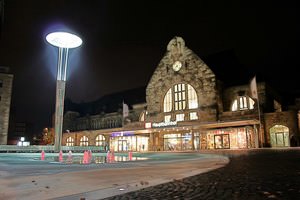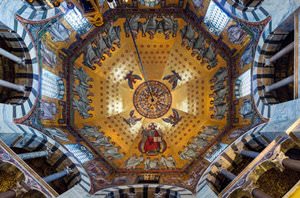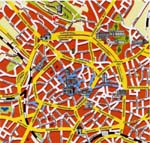Top architectural sightseeing and landmarks of Aachen - ideas on city exploration routes
 Of course, in order to feel the magnificent atmosphere of Aachen, one needs to visit this place, walk on charming streets of the historical center, visit local cafes, and enjoy the look of the local landmarks - Aachen Cathedral, Aachen Rathaus, Elisenbrunnen, Ponttor, RWTH Aachen University and many others. In order to make your virtual tour to the city more interactive, we offer an unusual opportunity to fly over every notable landmark of Aachen. Simply start the video, and use the full-screen mode. Each landmark comes with extra information, containing a collection of interesting facts and a photo gallery. Let’s go!
Of course, in order to feel the magnificent atmosphere of Aachen, one needs to visit this place, walk on charming streets of the historical center, visit local cafes, and enjoy the look of the local landmarks - Aachen Cathedral, Aachen Rathaus, Elisenbrunnen, Ponttor, RWTH Aachen University and many others. In order to make your virtual tour to the city more interactive, we offer an unusual opportunity to fly over every notable landmark of Aachen. Simply start the video, and use the full-screen mode. Each landmark comes with extra information, containing a collection of interesting facts and a photo gallery. Let’s go!
Aachen Cathedral, Aachen
Location on the map:  Facts:
Facts:
» The Roman Emperor wanted to build a palace with a prayer room. For this, architects from Rome and Byzantium were invited. Charles the Great was buried here. The sacred place with his remains has survived to this day. » The prayer room is octagonal. Arched vaults are decorated with colorful stones. Wall panels are covered with mosaics.
» A 12-m forged chandelier is lead. It symbolizes celestial Jerusalem. It was gifted by Frederick Barbarossa, one of the rulers in medieval Europe.
» In the hall, there is a preserved marble chair. It was gilded over time. Here, German kings were crowned.
» In the treasure trove, there are Christian relics: the white underwear of the Virgin Mary, the blanket of newborn Jesus, and the belt he wore when he was crucified. The authenticity of artifacts brought from the East has never been proven but they are spiritually invaluable.
» There is a belief that it had to take money from Satan to construct the cathedral. In this case, he must have taken the souls of the first person entering the house. Cunning citizens let a wolf in. You can see its statue at the entrance.
Aachen Rathaus, Aachen
Location on the map:  Facts:
Facts:
» The locals are proud of the Town Hall being an architectural monument. » In front of the building, different events - fairs, sports competitions, and concerts - are held. The citizens take an active part in them. There is also a museum and offices of the municipal authorities.
» The first stone was laid in the foundation in 1330. By the way, the foundation has left from the former building, the Imperial Palace. The construction lasted about 20 years.
» The building was burned several times but rose from ashes like a phoenix. When the Town Hall was reconstructed several times, new elements and premises appeared.
» The facade is decorated with 50 different stone statues. They depict the nobles and revered apostles. Wooden panels, a lot of wall frescoes depicting the scenes from the life of Charles the Great, and paintings of the settlements add certain flavor to the interior.
» In 1943, the enemy intended to destroy the house. After the war, it was thoroughly restored. The original pattern of wall fragments was reproduced to preserved drawings. Artists selected paints for it.
Elisenbrunnen, Aachen
Location on the map:  Facts:
Facts:
» In the 19th century, a thermal complex with fountains was built. The Imperial Spring produces water that is rich with minerals. The healing water has a temperature of 46 °C and tastes like hydrogen sulfide. » The legend says that unpleasant smell is associated with evil forces. A scary beast dwelt here in ancient times. The ruler beat it. It fell to the hot water channel and died. Since that time, the water is dark and smells bed.
» The Elisenbrunnen Complex and the park located in its surroundings are named after Princess Elizabeth, the daughter of Maximilian I. In the rotunda, you can see the painting of her on the wall, from which jets spurt.
» There are two swimming baths made of black African granite.
» Commemorative plaques say that a lot of eminent people visited this place: the Russian Tsar Peter the Great, Prussian King Frederick the Great, Italian adventurer Casanova, and others.
» In the years of the Second World War, the building was destroyed. It was restored in its original form in 1950.
» The locals set their hearts on this recreation area. Here, exhibitions and dance performances are often held.
Ponttor, Aachen
Location on the map:  Facts:
Facts:
» The Ponttor is a remaining gate. It was part of the cordon and protected the city. It was constructed in 1320. » The medieval tower was a place where people paid a tax when entering the city. In the separate room of the tower, prisoners were held. Since 1735, the construction had served as a school for decades.
» In the 40s of the last century, it was almost destroyed. It was decided to dismantle the gate due to their dilapidation. However, the construction was renovated. A public museum was opened here.
» Today, you can see the restored fortification in its original form.
» The rectangular four-level tower with an arched gate is surrounded with a metal fence. The walls are 4 m wide. They look lightweight because they are made of light sandstone. There is a canopy above the construction. Heated resin was poured from the drain on the wall.
» The word “ponttor” is a compound of two words, Latin “pons” (“crossing”) and German “tor” (closed shutters”).
» In the Ponttor, there is a school and house for members of the German Scout Association Saint George.
RWTH Aachen University, Aachen
Location on the map:  Facts:
Facts:
» RWTH Aachen University (Rheinisch-Westfälische Technische Hochschule Aachen) is a state higher education institution. It consists of 10 faculties. » Excellent specialists work in 260 departments. 410 educators have a professor’s degree. Over 8 000 workers work at the university.
» 30 000 students study here. Future entrants will master one of 75 professions. Every year, up to 5 000 new students enter the university. Young people from other countries can study here too.
» The university has two main programs: engineering and mathematical.
» The budget of the organization is €650 million. The university receives additional €150 million from industry. Industrial enterprises and public organizations support 2 000 projects.
» Those who head industrial plants or companies studied at RWTH Aachen University.
» The education institution was founded in 1870.
» Its campus is the largest in Europe.
» At the university, there are also research centers.
Theater Aachen, Aachen
Location on the map:  Facts:
Facts:
» Theater Aachen is a local attraction. » The project of the construction was presented in 1822. It was built three years after. The construction has excellent acoustics. The symphony orchestra gives concerts here.
» In 1943, a shell hit the building. The house was destroyed. Only its portico and lobby have survived.
» Several months after the war, the staff of the theater made performances but in other halls.
» After the wall, the building started to be renovated to preserved drawings.
» Now, you can see its original appearance. Gray outer walls and massive columns make the construction very magnificent. The facade is decorated with 8 Ionic pillars. The bas-relief depicts the god of art. Moldings add some sophistication to the construction.
» Inner rooms look modern too. Theatre-goers can enter the audience hall from a spacious lobby.
» In the restored building, the premiera performance was accompanied by opera.
» The troupe makes performances of various genres: operas, musicals, dramas, contemporary and classical plays, and music concerts.
Marschiertor, Aachen
Facts: » Two cylindrical four-level towers are linked with a five-storey building by arches. They are called “Marschiertor” or “Marching Gate”. The gate has left from an ancient fortification wall.
» The wall started to be built in 1257. It is not known when it was finished.
» The Marschiertor is a fortification of several circles. They are 24 m wide. A spiral staircase is added to each tower. Stairs lead to a gun room in the main building.
» On the ground floor, there were guardrooms and prison cells.
» The purpose of the gate depended on historical circumstances. There was a military unit at one time.
» Beyond it, there was a square for inspections and marching. That is why the construction is named “Marschiertor”.
» It protected the territory from enemies’ attacks. In commemoration of this, the memorable bronze statue of a warrior was put up here.
» Later, when there was no necessity in the defence, there were a bunkhouse, a tourist camp, and the Hitler Youth (Hitlerjugend), a Nazi youth organization. Nowadays, the construction seats the members of the Karnevals-Gesellschaft. There were also a wine cellar and an archive.
This guide to architectural sightseeing in Aachen is protected by the copyright law. You can re-publish this content with mandatory attribution: direct and active hyperlink to www.orangesmile.com.
City tours, excursions and tickets in Aachen and surroundings
Build your walking routes in Aachen on the landmark map
Saudi Arabia to Open 38 Hotels in Diriyah
Diriyah is one of the first mega projects in Saudi Arabia. Hotels and other infrastructure will start opening next year, and all works are expected to end in 2026. The first 18 restaurants in Bujairi Terrace will start operating already in early 2022. Read this
Read this
25.04.2024
Diriyah is one of the first mega projects in Saudi Arabia. Hotels and other infrastructure will start opening next year, and all works are expected to end in 2026. The first 18 restaurants in Bujairi Terrace will start operating already in early 2022.
25.04.2024


 English
English Russian
Russian Dutch
Dutch German
German Spanish
Spanish French
French Türkçe
Türkçe



















